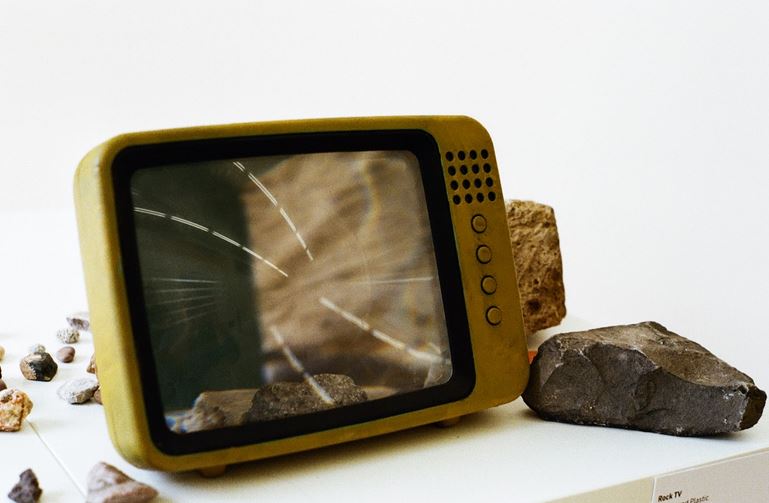By Francesca Lally
What is Rock TV?
Rock TV is an ongoing interdisciplinary project that was born from an in-class presentation many years ago with nothing but an overhead projector, a slideshow, some pebbles from the California desert, and a dream. It has evolved into a kind of speculative research-based drag performance, straddling pseudoscience and protocinema. It is a theory of geologic media, listening to what stones have to say about their role in the development of human civilization and mass media by looking into the history of technology and the inextricable relationships between collective memory and stone. I’ve shared Rock TV as a performance, a sculpture, and a script, but wanted to use my time at the Makerspace Residency to find another way to tell the story.
Rock TV in Just like a Book we can read also a Rock at the Gallery of Art, Temple University Rome. Photo by Ingrid Slater
Reprogramming Toys
After attending a presentation at the Association of Moving Image Archivists annual conference in 2022, I became enchanted by the creative possibilities of a children’s toy from the 1970s called the Fisher Price Movie Viewer. This device uses plastic cartridges of Super 8 film, a lens, and a hand crank to not only allow the viewer to watch their film without the use of any electricity, but also to control the frame rate of the picture, moving it both backward and forward through time. I had collected several of the Movie Viewers, and used my time in the Makerspace to disassemble the cartridges, create my own Super 8 looping abstract films of Rock TV.
Fisher Price Movie Viewer advertisement from the 1970s
Time in the Makerspace:
Using the tools in the makerspace, I was able to take the cartridges apart to examine their mechanics, threading, and even reclaim some of the films so that they could have a new life as Rock TV. I had initially thought that I would have to 3D print replacement parts, or a new cartridge entirely to reconstruct them after I had put in my own films, but was glad to discover this would not be necessary. The resource and time-saving wonders of low tech! Because of this, I was able to spend more time working on the films themselves as well as using the laser cutter, typewriter, and beginning to experiment with an instant thermal print camera I had also gotten as part of the residency.
Experimenting with re-threading the dissected cartridges.
Bleaching the emulsion off of the Super 8 film. Goodbye Snoopy, hello Rock TV!
Beginning to hand-color with Dr. Ph. Martin’s colored india inks, which are especially great for creating layers of color on celluloid.
In addition to adding color with ink, glitter nail polish, and stickers, I created my imagery on the film strips by scratching out tiny sequences on black leader, which plays one frame at a time through the viewfinder once loaded into the cartridge.
Once the internal pieces of the movie viewer puzzles were moving along, I worked with the laser cutter to create decorative mirrored panels to customize the devices exteriors. Hannah and Logan helped me transform a risograph print I had made about deep time using pieces of text from early Scottish geologists about Hutton’s Unconformity, a geological site where rock formations created at different times and by different processes lay one on top of the other, creating a kind of physical polytemporality.
The original risograph print, Metamorphic Incantation…..
…becomes laser cut mirrored plexiglass plates on the movie viewers.
And voila! They’re ready to be seen, inside and out.
Finally, I was inspired by the typewriter in the makerspace to create a hand-typed booklet of the script I use for the performance of Rock TV. I used dura-lar film for the pages, the semi-visible layers of text mimicking geologic strata, and bound it with a single metal ring to continue with the themes of cyclical time without a beginning or end.
Past, Present, and Future Exhibitions:
The typed booklet is the first piece from the residency to be displayed in a gallery. It was included with the sculpture of Rock TV for Vox Populi’s 19th juried exhibition this summer in Philadelphia. While the movie viewers haven’t made their debut just yet, they and the booklet serve a similar and complementary function to the piece. Both of them allow the viewer to interact with Rock TV at their own pace, in their own time. What happens to a story when instead of being told it is activated by and unfolding in the hands of the viewers themselves? It was great to share the work in this way and with so many other local artists making work that blends technology and speculative science fiction.
I am so excited to see what it will be like to exhibit the Movie Viewer devices, both as part of the larger constellation of Rock TV works and on their own. I’m curious to see how continuing to shift the presentation from a lecture-style performance to a sculpture and booklet, and now to a hand-activated cinema, how Rock TV will continue to open itself up to broader interpretations, furthering creative conversations about the tectonics of history and humanity’s part in the natural world throughout time. Working now on my MFA thesis exhibition, the work I’ve created during this residency has opened up my practice to new possibilities of hacking existing cinematic technologies to tell new stories.
